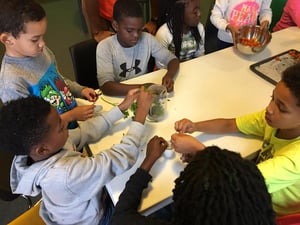
Backpack, paper, pencils, and homework folder: for many families, that’s the standard shopping list for back-to-school season. However, one key item is missing: your child’s afterschool program! Choosing the perfect program for your child can make the transition from early child care to aftercare seem daunting, but it doesn’t have to be! We want to provide you with some tips that will make choosing a program easy and exciting.
Afterschool programs are a great way to keep your child safe, inspire them to learn, and introduce them to positive role models. Rather than spending the hours after school sitting at home, afterschool programs can provide students with an afterschool snack, academic enrichment, and a range of engaging and interactive activities including: painting, poetry, science experiments, reading, theatre, foreign languages, sports, cooking, and more!
With so many choices, how is a parent to decide the right program? Well, these important qualities can guide your decision and ensure your child’s success:
- Low child-to-staff ratio
- A positive emotional climate
- A clear program structure
- Appropriate supervision
- Activities that promote autonomy and choice
- Continuity with the regular school day
Furthermore, out-of-school time has the potential to promote your child’s health and wellness. Here are some guidelines to choosing a safe and healthy afterschool program.
Your Child’s Key to Health (and Success)
Did you know that the National Afterschool Association (NAA) recommends a set of Healthy Eating and Physical Activity (HEPA) standards that provide students with nutritious foods, keep them physically fit, and promote their health? Programs that follow the HEPA standards promote lifelong health and healthy childhood weight by serving a fruit or vegetable on a daily basis, offering evidence-based nutrition education classes, dedicating at least 30-minutes of program time to physical activity, ensuring all staff leading physical activities are first aid/CPR certified, and more.
In addition to healthy outcomes for your child, the Healthy Out-of-School Time Coalition (HOST) highlights studies demonstrating youth that eat healthier and move more get better grades, attend school more often, and have improved self-esteem, social-relationships, and leadership skills. Use the HEPA standards as a guide for choosing a program that prioritizes your child’s health.
Paying for Healthy Aftercare Doesn’t Have to Break the Bank
The 2014 reauthorized version of the Child Care and Development Block Grant (CCDBG) Act strengthened the requirements to protect the health and safety of children in care. In addition to providing subsidies for children ages 0-5, the CCDBG also provides subsidies to school-aged children in afterschool programs.
Families can receive subsidies that reimburse afterschool costs by selecting any legally operating child care provider that meets basic health and safety requirements established by the state or tribe. The first step in applying for subsidized afterschool programs is to find your state or tribe’s requirements by using the contact information provided by the Office of Child Care (OCC).
Parents should also be aware of the 21st Century Community Learning Centers (21st CCLC). The Department of Education provides grants to support afterschool programs through the 21st CCLC that provide academic enrichment, family engagement, and a broad array of additional services, programs, and activities focusing on youth development, health education, STEM, and more. If you are wondering where you can find a Community Learning Center, check to see if your school participates. According to the Afterschool Alliance, close to 90 percent of 21st CCLC are located in schools!
Making the Choice
If your school doesn’t have their own afterschool program, try contacting the following community organizations to discuss opportunities about safe and healthy out-of-school time for your kindergartener:
- YMCA: 1-888-333-YMCA
- Boys & Girls Clubs of America: 1-800-854-CLUB
- 4-H Council
- Girls, Inc.: (212) 509-2000
- Camp Fire USA
- Police Athletic Leagues
- After School All Stars
- Your city or county’s Park & Recreation Department
- Local libraries, churches, synagogues, and mosques
With these tips and tools, we hope you are feeling confident in your ability to make an informed decision as you consider different afterschool programs for your child!
The Afterschool Alliance works to ensure that all youth have access to affordable, quality afterschool programs. The mission of NAFCC includes increasing public and private investment in quality afterschool program initiatives at the national, state and local levels.






